

 チュートリアル チュートリアル | (トピック一覧へ戻る) |
 パネル化アルゴリズム例その10
パネル化アルゴリズム例その10![]()
![]()
![]()
![]()
import processing.opengl.*;
import igeo.*;
size(480, 360, IG.GL);
IG.open("surface11.3dm");
ISurface[] surfaces = IG.surfaces();
for (ISurface surf : surfaces) {
int unum = 30, vnum = 30;
double uinc = 1.0/unum, vinc = 1.0/vnum;
double gap = 0.25;
for(int i=0; i < unum; i++){
for(int j=0; j < vnum; j++){
IVec pt1 = surf.pt( i*uinc, j*vinc );
IVec pt2 = surf.pt( (i+1-gap)*uinc, j*vinc );
IVec pt3 = surf.pt( (i+1-gap)*uinc, (j+1-gap)*vinc );
IVec pt4 = surf.pt( i*uinc, (j+1-gap)*vinc );
new ISurface(pt1,pt2,pt3,pt4);
}
}
surf.del();
}
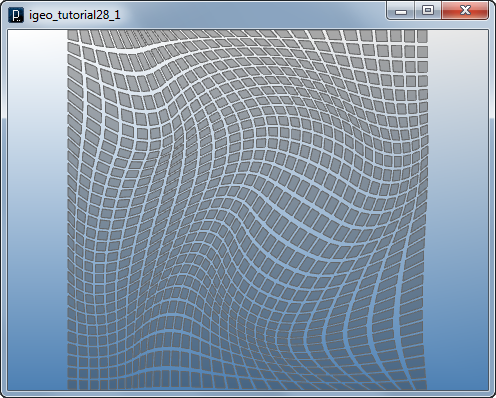
次のコードではランダムに選択された四角形を三角形に分割します。 それから四角形または三角形の線を描き、その線を内部にオフセットし、 それからZ軸方向に押し出して多角形状のパイプを生成します。
![]()
![]()
![]()
![]()
import processing.opengl.*;
import igeo.*;
size(480, 360, IG.GL);
IG.open("surface11.3dm");
ISurface[] surfaces = IG.surfaces();
for (ISurface surf : surfaces) {
int unum = 30, vnum = 30;
double uinc = 1.0/unum, vinc = 1.0/vnum;
double offsetDist = -0.04;
int degree = 1; // 1 or 2
for(int i=0; i < unum; i++){
for(int j=0; j < vnum; j++){
IVec pt1 = surf.pt( i*uinc, j*vinc );
IVec pt2 = surf.pt( (i+1)*uinc, j*vinc );
IVec pt3 = surf.pt( (i+1)*uinc, (j+1)*vinc );
IVec pt4 = surf.pt( i*uinc, (j+1)*vinc );
if(IRandom.percent(30)){ // rectangle
ICurve crv = new ICurve(new IVec[]{ pt1, pt2, pt3, pt4 }, degree, true);
ICurve offCrv = IG.offset(crv, offsetDist);
IG.extrude(offCrv, -4).clr(0.2);
}
else if(IRandom.percent(30)){ // triangles
ICurve crv = new ICurve(new IVec[]{ pt1, pt2, pt3 }, degree, true);
ICurve offCrv = IG.offset(crv, offsetDist);
IG.extrude(offCrv, -2).clr(0.2);
ICurve crv2 = new ICurve(new IVec[]{ pt1, pt3, pt4 }, degree, true);
ICurve offCrv2 = IG.offset(crv2, offsetDist);
IG.extrude(offCrv2, -2).clr(0.2);
}
else{ // triangles in other direction
ICurve crv = new ICurve(new IVec[]{ pt1, pt2, pt4 }, degree, true);
ICurve offCrv = IG.offset(crv, offsetDist);
IG.extrude(offCrv, -1).clr(0.2);
ICurve crv2 = new ICurve(new IVec[]{ pt2, pt3, pt4 }, degree, true);
ICurve offCrv2 = IG.offset(crv2, offsetDist);
IG.extrude(offCrv2, -1).clr(0.2);
}
}
}
surf.del();
}
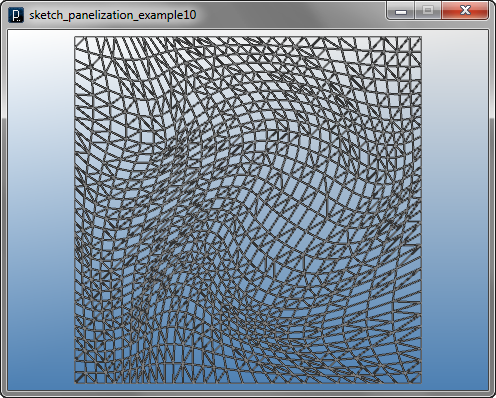
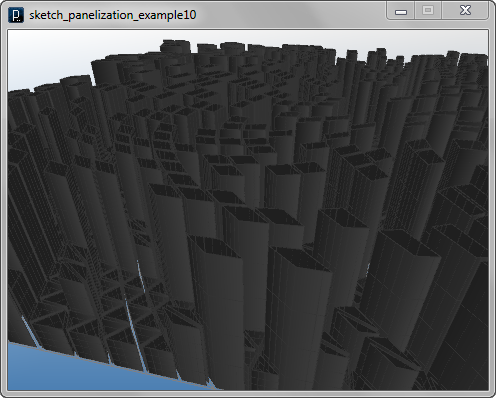
変数degreeは、四角形と三角形の線のNURBS次数を決めていますが、 これを1から2に変更すると、生成される形状も多角形状から、曲面状に代わります。
![]()
![]()
![]()
![]()
import processing.opengl.*;
import igeo.*;
size(480, 360, IG.GL);
IG.open("surface11.3dm");
ISurface[] surfaces = IG.surfaces();
for (ISurface surf : surfaces) {
int unum = 30, vnum = 30;
double uinc = 1.0/unum, vinc = 1.0/vnum;
double offsetDist = -0.04;
int degree = 2; // 1 or 2
for(int i=0; i < unum; i++){
for(int j=0; j < vnum; j++){
IVec pt1 = surf.pt( i*uinc, j*vinc );
IVec pt2 = surf.pt( (i+1)*uinc, j*vinc );
IVec pt3 = surf.pt( (i+1)*uinc, (j+1)*vinc );
IVec pt4 = surf.pt( i*uinc, (j+1)*vinc );
if(IRandom.percent(30)){ // rectangle
ICurve crv = new ICurve(new IVec[]{ pt1, pt2, pt3, pt4 }, degree, true);
ICurve offCrv = IG.offset(crv, offsetDist);
IG.extrude(offCrv, -4).clr(0.2);
}
else if(IRandom.percent(30)){ // triangles
ICurve crv = new ICurve(new IVec[]{ pt1, pt2, pt3 }, degree, true);
ICurve offCrv = IG.offset(crv, offsetDist);
IG.extrude(offCrv, -2).clr(0.2);
ICurve crv2 = new ICurve(new IVec[]{ pt1, pt3, pt4 }, degree, true);
ICurve offCrv2 = IG.offset(crv2, offsetDist);
IG.extrude(offCrv2, -2).clr(0.2);
}
else{ // triangles in other direction
ICurve crv = new ICurve(new IVec[]{ pt1, pt2, pt4 }, degree, true);
ICurve offCrv = IG.offset(crv, offsetDist);
IG.extrude(offCrv, -1).clr(0.2);
ICurve crv2 = new ICurve(new IVec[]{ pt2, pt3, pt4 }, degree, true);
ICurve offCrv2 = IG.offset(crv2, offsetDist);
IG.extrude(offCrv2, -1).clr(0.2);
}
}
}
surf.del();
}
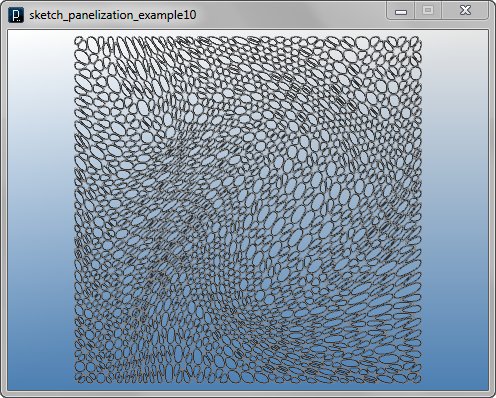

 次のコードは画像の入力を一つ取ります。
この画像のグレー値が半分以下(0.5)の場合にのみ、
幾何学オブジェクトを生成するので、
結果として画像の明るい部分は空いた空間となります。
例では右の画像を"voidmap.jpg"として用いています。
次のコードは画像の入力を一つ取ります。
この画像のグレー値が半分以下(0.5)の場合にのみ、
幾何学オブジェクトを生成するので、
結果として画像の明るい部分は空いた空間となります。
例では右の画像を"voidmap.jpg"として用いています。
![]()
![]()
![]()
![]()
import processing.opengl.*;
import igeo.*;
size(480, 360, IG.GL);
IG.open("surface11.3dm");
ISurface[] surfaces = IG.surfaces();
IImageMap map1 = new IImageMap("voidmap.jpg");
for (ISurface surf : surfaces) {
int unum = 30, vnum = 30;
double uinc = 1.0/unum, vinc = 1.0/vnum;
double offsetDist = -0.04;
int degree = 1; // 1 or 2
for(int i=0; i < unum; i++){
for(int j=0; j < vnum; j++){
IVec pt1 = surf.pt( i*uinc, j*vinc );
IVec pt2 = surf.pt( (i+1)*uinc, j*vinc );
IVec pt3 = surf.pt( (i+1)*uinc, (j+1)*vinc );
IVec pt4 = surf.pt( i*uinc, (j+1)*vinc );
if(map1.get( (i+0.5)*uinc, (j+0.5)*vinc ) < 0.5 ){
if(IRandom.percent(30)){
ICurve crv = new ICurve(new IVec[]{ pt1, pt2, pt3, pt4 }, degree, true);
ICurve offCrv = IG.offset(crv, offsetDist);
IG.extrude(offCrv, -3).clr(0.2);
}
else if(IRandom.percent(30)){
ICurve crv = new ICurve(new IVec[]{ pt1, pt2, pt3 }, degree, true);
ICurve offCrv = IG.offset(crv, offsetDist);
IG.extrude(offCrv, -2).clr(0.2);
ICurve crv2 = new ICurve(new IVec[]{ pt1, pt3, pt4 }, degree, true);
ICurve offCrv2 = IG.offset(crv2, offsetDist);
IG.extrude(offCrv2, -2).clr(0.2);
}
else{
ICurve crv = new ICurve(new IVec[]{ pt1, pt2, pt4 }, degree, true);
ICurve offCrv = IG.offset(crv, offsetDist);
IG.extrude(offCrv, -1).clr(0.2);
ICurve crv2 = new ICurve(new IVec[]{ pt2, pt3, pt4 }, degree, true);
ICurve offCrv2 = IG.offset(crv2, offsetDist);
IG.extrude(offCrv2, -1).clr(0.2);
}
}
}
}
surf.del();
}
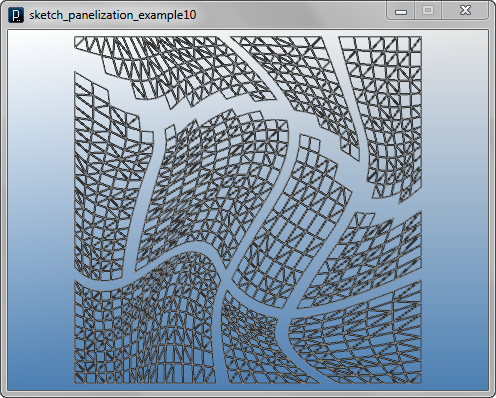
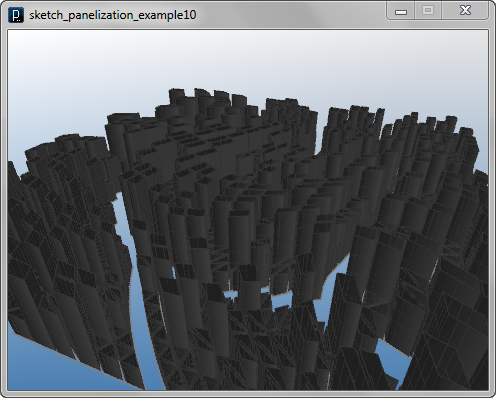
次の例では5つの異なる画像を用意し、それをそれぞれ
空き、高さ、高さのランダム化、三角か四角の選択、色の制御に用います。
用いる画像は左から"voidmap.jpg"、 "heightmap.jpg"、
"heightRandomizeMap.jpg"、 "divisionmap.jpg"、
"colormap.jpg"です。
高さの画像の暗いところは低いチューブが生成され、明るいところに高いものが生成されます。
高さのランダム化の部分では、画像が暗いと一定の高さですが、そうでないところはランダムに高さが変わります。
三角か四角の選択では、画像が暗いと四角、そうでないと三角となり、三角分割の2種類の方向はランダムに決定されます。





![]()
![]()
![]()
![]()
import processing.opengl.*;
import igeo.*;
size(480, 360, IG.GL);
IG.open("surface11.3dm");
ISurface[] surfaces = IG.surfaces();
IImageMap map1 = new IImageMap("voidmap.jpg");
IImageMap map2 = new IImageMap("heightmap.jpg");
IImageMap map3 = new IImageMap("heightRandomizeMap.jpg");
IImageMap map4 = new IImageMap("divisionmap.jpg");
IImageMap map5 = new IImageMap("colormap.jpg");
for (ISurface surf : surfaces) {
int unum = 30, vnum = 30;
double uinc = 1.0/unum, vinc = 1.0/vnum;
double offsetDist = -0.04;
int degree = 1; // 1 or 2
double maxHeight = 2;
double heightRandomizeRange = 2.5;
for(int i=0; i < unum; i++){
for(int j=0; j < vnum; j++){
IVec pt1 = surf.pt( i*uinc, j*vinc );
IVec pt2 = surf.pt( (i+1)*uinc, j*vinc );
IVec pt3 = surf.pt( (i+1)*uinc, (j+1)*vinc );
IVec pt4 = surf.pt( i*uinc, (j+1)*vinc );
double division =
map4.get((i+0.5)*uinc,(j+0.5)*vinc)*maxHeight;
double height =
map2.get((i+0.5)*uinc,(j+0.5)*vinc)*maxHeight;
height += map3.get((i+0.5)*uinc,(j+0.5)*vinc) *
IRandom.get(0,heightRandomizeRange);
if(map1.get( (i+0.5)*uinc, (j+0.5)*vinc ) < 0.5 ){
if(division < 0.5){
ICurve crv = new ICurve(new IVec[]{ pt1, pt2, pt3, pt4 }, degree, true);
ICurve offCrv = IG.offset(crv, offsetDist);
IG.extrude(offCrv, -height).clr(map5.clr((i+0.5)*uinc, (j+0.5)*vinc));
}
else if(IRandom.percent(50)){
ICurve crv = new ICurve(new IVec[]{ pt1, pt2, pt3 }, degree, true);
ICurve offCrv = IG.offset(crv, offsetDist);
IG.extrude(offCrv, -height).clr(map5.clr((i+0.5)*uinc, (j+0.5)*vinc));
ICurve crv2 = new ICurve(new IVec[]{ pt1, pt3, pt4 }, degree, true);
ICurve offCrv2 = IG.offset(crv2, offsetDist);
IG.extrude(offCrv2, -height).clr(map5.clr((i+0.5)*uinc, (j+0.5)*vinc));
}
else{
ICurve crv = new ICurve(new IVec[]{ pt1, pt2, pt4 }, degree, true);
ICurve offCrv = IG.offset(crv, offsetDist);
IG.extrude(offCrv, -height).clr(map5.clr((i+0.5)*uinc, (j+0.5)*vinc));
ICurve crv2 = new ICurve(new IVec[]{ pt2, pt3, pt4 }, degree, true);
ICurve offCrv2 = IG.offset(crv2, offsetDist);
IG.extrude(offCrv2, -height).clr(map5.clr((i+0.5)*uinc, (j+0.5)*vinc));
}
}
}
}
surf.del();
}
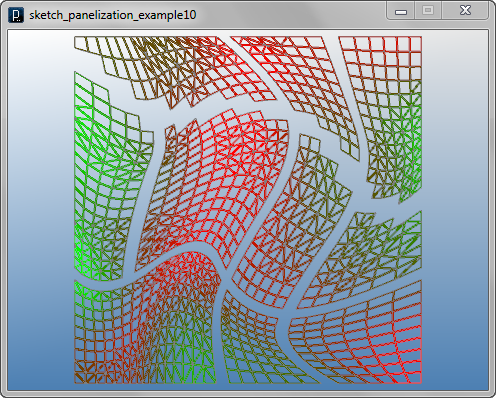
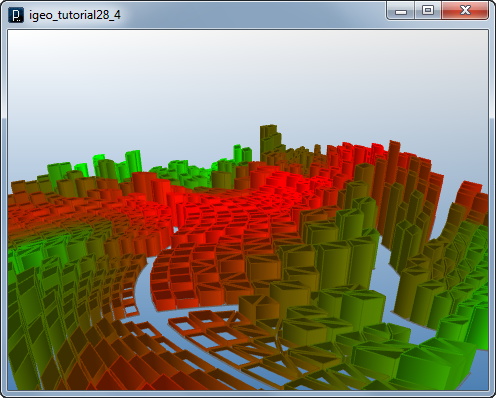
以下はNURBS次数を2にした、曲面の場合です。
![]()
![]()
![]()
![]()
import processing.opengl.*;
import igeo.*;
size(480, 360, IG.GL);
IG.open("surface11.3dm");
ISurface[] surfaces = IG.surfaces();
IImageMap map1 = new IImageMap("voidmap.jpg");
IImageMap map2 = new IImageMap("heightmap.jpg");
IImageMap map3 = new IImageMap("heightRandomizeMap.jpg");
IImageMap map4 = new IImageMap("divisionmap.jpg");
IImageMap map5 = new IImageMap("colormap.jpg");
for (ISurface surf : surfaces) {
int unum = 30, vnum = 30;
double uinc = 1.0/unum, vinc = 1.0/vnum;
double offsetDist = -0.04;
int degree = 2; // 1 or 2
double maxHeight = 2;
double heightRandomizeRange = 2.5;
for(int i=0; i < unum; i++){
for(int j=0; j < vnum; j++){
IVec pt1 = surf.pt( i*uinc, j*vinc );
IVec pt2 = surf.pt( (i+1)*uinc, j*vinc );
IVec pt3 = surf.pt( (i+1)*uinc, (j+1)*vinc );
IVec pt4 = surf.pt( i*uinc, (j+1)*vinc );
double division = map4.get((i+0.5)*uinc,(j+0.5)*vinc)*maxHeight;
double height = map2.get((i+0.5)*uinc,(j+0.5)*vinc)*maxHeight;
height += map3.get((i+0.5)*uinc,(j+0.5)*vinc) * IRandom.get(0,heightRandomizeRange);
if(map1.get( (i+0.5)*uinc, (j+0.5)*vinc ) < 0.5 ){
if(division < 0.5){
ICurve crv = new ICurve(new IVec[]{ pt1, pt2, pt3, pt4 }, degree, true);
ICurve offCrv = IG.offset(crv, offsetDist);
IG.extrude(offCrv, -height).clr(map5.clr((i+0.5)*uinc, (j+0.5)*vinc));
}
else if(IRandom.percent(50)){
ICurve crv = new ICurve(new IVec[]{ pt1, pt2, pt3 }, degree, true);
ICurve offCrv = IG.offset(crv, offsetDist);
IG.extrude(offCrv, -height).clr(map5.clr((i+0.5)*uinc, (j+0.5)*vinc));
ICurve crv2 = new ICurve(new IVec[]{ pt1, pt3, pt4 }, degree, true);
ICurve offCrv2 = IG.offset(crv2, offsetDist);
IG.extrude(offCrv2, -height).clr(map5.clr((i+0.5)*uinc, (j+0.5)*vinc));
}
else{
ICurve crv = new ICurve(new IVec[]{ pt1, pt2, pt4 }, degree, true);
ICurve offCrv = IG.offset(crv, offsetDist);
IG.extrude(offCrv, -height).clr(map5.clr((i+0.5)*uinc, (j+0.5)*vinc));
ICurve crv2 = new ICurve(new IVec[]{ pt2, pt3, pt4 }, degree, true);
ICurve offCrv2 = IG.offset(crv2, offsetDist);
IG.extrude(offCrv2, -height).clr(map5.clr((i+0.5)*uinc, (j+0.5)*vinc));
}
}
}
}
surf.del();
}

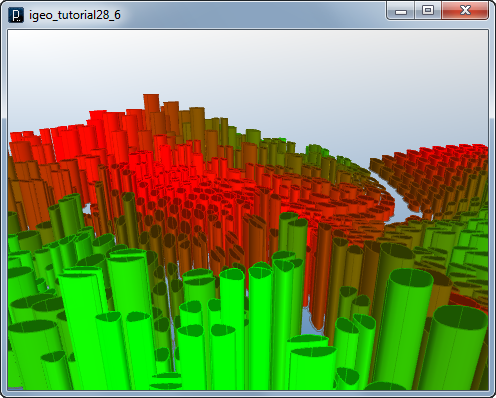
 HOME
HOME
 FOR PROCESSING
FOR PROCESSING
 DOWNLOAD
DOWNLOAD
 DOCUMENTS
DOCUMENTS
 TUTORIALS (Java /
Python)
TUTORIALS (Java /
Python)
 GALLERY
GALLERY
 SOURCE CODE(GitHub)
SOURCE CODE(GitHub)
 PRIVACY POLICY
PRIVACY POLICY
 ABOUT/CONTACT
ABOUT/CONTACT
